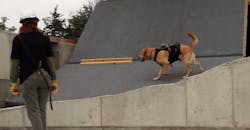An oil spill here, a brush fire there. And all within a pretty unfortunate 52-acres of destruction.
Is this the post-apocalyptic world?
No. In fact, this is training.
“It basically looks like a Hollywood set,” says Walt Magnussen, director of telecommunications at Texas A&M University since 2004. Inside the expansive College Station, Texas grounds search and rescue dogs refine their skillset nosing through rubble piles and collapsed buildings on the premises of Disaster City—potentially the world’s largest search and rescue training facility. Disaster City is part of the engineering extension service at Texas A&M. The program, in operation for close to 80 years, is a giant when it comes to first responder training for police and fire. The fire school alone trains roughly 52,000 people a year. The area inside Disaster City called Brighton Fire Field has everything from refinery rigs, ship and trains that have derailed, to bits and pieces of crashed planes.
Volunteers rehearse scenarios, and then head over to makeup where they are painted up and given the full-on victim treatment. This place is, indeed, a well-orchestrated, larger-than-life test run.
Communication in an emergency
This training couldn’t be nearly as authentic as the real deal, if someone weren’t behind-the-scenes making sure all hands on deck can communicate with one another. In addition to working the telecommunications sector, A&M’s Magnussen also directs the Internet2 Technology Evaluation Center (ITEC), a consortium of the leading 229 researched universities in the U.S. ITEC works to implement new communications technology for first responders amid the epic training grounds, year-round.
The idea is, if a real large-scale catastrophe were to happen, fire and EMS from multiple jurisdictions will respond and need to communicate seamlessly with one another. Pioneering networks are making this worlds easier by incorporating things like video, text, and data prioritization into that initial (life-saving) conversation.
But before we go forward, we have to go back. Eight years ago Magnussen recalls ITEC received a grant from the Department of Transportation to start work in the NG911 space. “We built the first-ever NG911 system for the U.S. DOT on a proof of concept project they were doing,” he says. Then in 2009 the center began interoperability testing with NENA. More recently in 2010, 2011 the center started working on the public safety broadband (dubbed FirstNet in 2012).
ITEC supports the applications that run on the network, including video, and they continue to amass a decent collection of technology in the lab. Magnussen estimates there’s close to $6 million of technology in the lab to support public safety exercises and events.
Hands-on tech trials
The big question is, “How do we get what we have currently usable into the hands of the folks who are going to actually need it?” says Magnussen.
To accomplish this, the group conducts exercises twice a year. They get new systems and devices into the hands of first responders and then listen to the feedback—what to add, what to take away, how does it need to work. “More important, public safety will basically be redefining their operations as these extra capabilities come into play,” says Magnussen.
“If you think about how to operate in the business world today, I guarantee the way you operate today is significantly different than it was 15 years ago before smartphones and wireless networks. Those [things] change the way you operate, and there’s no doubt you’re going to see the same things with public safety.”
The Winter Institute and Summer Institute at Disaster City offer more technology-oriented exercises so responders can get a feel for what’s coming down the line. At the Winter Institute it’s not uncommon to see cameras on top of drones or German Shepherds equipped with microphone, camera, and speakers. All of this information, then—this data—is funneled to boots on the ground.
Benefits of FirstNet
Mobile devices are a significant game-changer as public safety moves towards FirstNet and a wider availability of LTE, as users can get more information to and from people in the field. “The more you can improve the response and reduce the time to response, the smaller the incident becomes,” says John Rennie, general manager of the Public Safety Global Business Unit for NICE Systems. Rennie and Magnussen worked together at Texas A&M.
Winter Institute and Summer Institute exercises at Disaster City largely center on the issue of interoperability. “I’d say the industry pretty well has their ducks in a row when it comes to the PTT and land mobile radio world. But what is happening right now is that the industry is also transitioning to a data center type environment where we have access to high-speed public broadband networks,” says Magnussen.
These new networks are based on 3GPP standards, the same that commercial cellular providers use.
Now public safety is pushing in that direction, hoping to acquire easy roaming via different LTE networks that support interoperability. But one problem remains: even now not every network is LTE…and perhaps won’t be for quite some time. This includes NG911—the network citizens use to convey information to emergency call-takers. “One of the reasons we’re changing NG911 is so we have other sources of media,” Magnussen says. Whereas E911 was designed for voice-only, NG911 will incorporate more types of data—which is a help first and foremost to dispatchers and first responders.
Enter video
“In the U.S. (in public safety), video is coming relatively slowly but increasing in pace,” says Rennie of NICE Systems, noting that in many agencies video started small—often as a pilot-type project. Maybe a few cameras were acquired for a political convention or sporting event. But he adds “even for those not familiar with [video-based management systems] it’s a very simple, very easy thing to pick up.”
One example of current video integration is NICE’s video management system (called NiceVision) that can connect to any camera, whether fixed or mobile—perhaps on a drone. The system brings multiple cameras to one point for easy viewing, sharing and after-the-fact analysis. It is designed to scale-up to allow for managing video in a large environment.
The main use for NICE Vision is for field awareness before responders reach the scene. Imagine there’s been an explosion. First the dispatch manager receives an alert with a location. Then you tie that map to your cameras to determine which cameras you have looking at that location. “In the midst of the dispatch and everything else you’re normally doing, you also have someone reviewing the scene live if they have time…looking back at how that scene developed, and that helps you determine the right resources to send,” says Rennie.
Coming down the line, the next step in video is increasing analytics and correlation. That is, being able alert something’s going on without people needing to look at the picture. Things like spotting abnormal behavior in a crowd, and predicting future events from the information at-hand.
And with better data, of course, comes better apps.
“I could never have guess the apps that are going to drive wireless, but now that the network is there, there are new apps coming out every day,” says Magnussen.
The Internet of Things (IoT) and dispatch
Who monitors video data is up for debate. In some places it’s the supervisor in dispatch or 911 center. A few of the larger agencies are setting up centers that handle video as a primary source. “At the moment…a person contacts a 911 center and the center dispatches people to get them on-scene. All these other things like video really sit side by side with those. My long-term vision would be you get to a point where [citizens] don’t really need to call 911, because some level of automatic notification has already taken place that someone needs help. We can see some of this coming with the crash notification in cars, for example,” says Rennie.
The Internet of Things introduces a paradigm shift where people don’t call needing help, rather systems instantly notify of people needing help. Rennie says this will undoubtedly have an effect on the way operations are run, the expectations people have, and how emergency responders are set up in the field.
Embracing change
One could argue the new modes of communication are actually driving disaster response methods—with the intent to get things does faster, and more efficiently.
Magnussen says they are scheduling the next Winter Institute for October 2015, with part of the training in Galveston, Texas to include cross-border exercises. “We did one last November that involved a large range fire that started in Canada, Saskatchewan and came down across the border into Montana. So now you’ve got first responders in the U.S. and Canada working together…separated by a border.”
This is a place where trainees come together from different backgrounds with mixed levels of experience. But one unifying factor is—ideally—that all of these first responders will be prepped and ready when the next disaster hits.

Sara Scullin
Sara Scullin was the Editor of Law Enforcement Technology magazine, a monthly business-to-business publication that covers technology trends and best practices for public safety managers. LET is part of SouthComm Law Enforcement Media, which also publishes Law Enforcement Product News and Officer.com. Sara had covered the law enforcement industry since March 2008.



